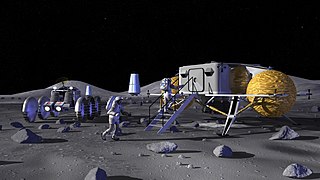
The Ames Research Center (ARC), also known as NASA Ames, is a major NASA research center at Moffett Federal Airfield in California's Silicon Valley. It was founded in 1939 as the second National Advisory Committee for Aeronautics (NACA) laboratory. That agency was dissolved and its assets and personnel transferred to the newly created National Aeronautics and Space Administration (NASA) on October 1, 1958. NASA Ames is named in honor of Joseph Sweetman Ames, a physicist and one of the founding members of NACA. At last estimate NASA Ames has over US$3 billion in capital equipment, 2,300 research personnel and a US$860 million annual budget.
The space program of the People's Republic of China is directed by the China National Space Administration (CNSA). Its technological roots can be traced back to the late 1950s, when China began a ballistic missile program in response to perceived American threats. However, the first Chinese crewed space program only began several decades later, when an accelerated program of technological development culminated in Yang Liwei's successful 2003 flight aboard Shenzhou 5. This achievement made China the third country to independently send humans into space. Plans currently include a permanent Chinese space station in 2022, crewed expeditions to the Moon and interplanetary missions to explore the Solar System and beyond.

China National Space Administration (CNSA) is the national space agency of China responsible for the national space program and for planning and development of space activities. CNSA and China Aerospace Science and Technology Corporation (CASC) assumed the authority over space development efforts previously held by the Ministry of Aerospace Industry. It is a subordinate agency of the State Administration for Science, Technology and Industry for National Defence (SASTIND), itself a subordinate agency of the Ministry of Industry and Information Technology (MIIT).

The Discovery Program is a series of Solar System exploration missions funded by the US National Aeronautics and Space Administration (NASA) through its Planetary Missions Program Office. Each mission has a cost cap, at a lower level than a mission from NASA's New Frontiers or Flagship Programs. As a result, Discovery missions tend to be more focused on a specific scientific goal.

The National Aeronautics and Space Act of 1958 is the United States federal statute that created the National Aeronautics and Space Administration (NASA). The Act, which followed close on the heels of the Soviet Union's launch of Sputnik, was drafted by the United States House Select Committee on Astronautics and Space Exploration and on July 29, 1958 was signed by President Eisenhower. Prior to enactment, the responsibility for space exploration was deemed primarily a military venture, in line with the Soviet model that had launched the first orbital satellite. In large measure, the Act was prompted by the lack of response by a US military infrastructure that seemed incapable of keeping up the space race.
The Lunar and Planetary Institute (LPI) is a scientific research institute dedicated to study of the solar system, its formation, evolution, and current state. The Institute is part of the Universities Space Research Association (USRA) and is supported by the Science Mission Directorate of the National Aeronautics and Space Administration (NASA). Located at 3600 Bay Area Boulevard in Houston, Texas, the LPI maintains an extensive collection of lunar and planetary data, carries out education and public outreach programs, and offers meeting coordination and publishing services. The LPI sponsors and organizes several workshops and conferences throughout the year, including the Lunar and Planetary Science Conference (LPSC) held in March in the Houston area.

The Chinese Lunar Exploration Program, also known as the Chang'e Project after the Chinese moon goddess Chang'e, is an ongoing series of robotic Moon missions by the China National Space Administration (CNSA). The program incorporates lunar orbiters, landers, rovers and sample return spacecraft, launched using Long March rockets. Launches and flights are monitored by a telemetry, tracking, and command (TT&C) system, which uses 50-meter (160-foot) radio antennas in Beijing and 40-meter (130-foot) antennas in Kunming, Shanghai, and Ürümqi to form a 3,000-kilometer (1,900-mile) VLBI antenna. A proprietary ground application system is responsible for downlink data reception.

A moonbase is a facility on the Moon, enabling human activity at the Moon.
Astronauts hold a variety of ranks and positions. Each of these roles carries responsibilities that are essential to the operation of a spacecraft. A spacecraft's cockpit, filled with sophisticated equipment, requires skills differing from those used to manage the scientific equipment on board, and so on.
Space policy is the political decision-making process for, and application of, public policy of a state regarding spaceflight and uses of outer space, both for civilian and military purposes. International treaties, such as the 1967 Outer Space Treaty, attempt to maximize the peaceful uses of space and restrict the militarization of space.

The National Aeronautics and Space Administration is an independent agency of the U.S. federal government responsible for the civilian space program, as well as aeronautics and space research.
The politics of outer space includes space treaties, law in space, international cooperation and conflict in space exploration, international economics and the hypothetical political impact of any contact with extraterrestrial intelligence.

The space policy of the United States includes both the making of space policy through the legislative process, and the implementation of that policy in the civilian and military US space programs through regulatory agencies. The early history of United States space policy is linked to the US–Soviet Space Race of the 1960s, which gave way to the Space Shuttle program. There is a current debate on the post-Space Shuttle future of the civilian space program.

The Algerian Space Agency, (ASAL) was established on January 16, 2002 in Bouzareah, Algiers. The agency is in charge of the Algerian space program. ASAL has flown five different satellites.
The State Administration of Science, Technology and Industry for National Defense is a civilian ministry within the State Council of the People's Republic of China and is a subordinate agency of the Chinese Ministry of Industry and Information Technology and the superseding agency of the Commission for Science, Technology and Industry for National Defense (COSTIND). It was created by the Plan for Restructuring the State Council passed by the First Session of the Eleventh National People's Congress in 2008.

William J. (Bill) Borucki is a space scientist who worked at the NASA Ames Research Center. Upon joining NASA in 1962, Borucki designed the heat shields for Apollo program spacecraft. He later turned his attention to the optical efficiency of lightning strikes in the atmospheres of planets, investigating the propensity that these lightning strikes could create molecules that would later become the precursors for life. Subsequently, Borucki's attention turned to extrasolar planets and their detection, particularly through the transit method. In light of this work, Borucki was named the principal investigator for NASA's Kepler mission, launched on March 6, 2009 and dedicated to a transit-based search for habitable planets. In 2013, Borucki was awarded the United States National Academy of Sciences's Henry Draper Medal for his work with Kepler. In 2015 he received the Shaw Prize in Astronomy.
Chang'e 6 is a planned robotic Chinese lunar exploration mission expected to be launched in 2023 or 2024 and perform China's second sample return mission. Like its predecessors, the spacecraft is named after the Chinese moon goddess Chang'e.

Luna 26 is a planned lunar polar orbiter, part of the Luna-Glob program, by Roscosmos. In addition to its scientific role, the Luna 26 orbiter would also function as a telecomm relay between Earth and Russian landed assets. This mission was announced in November 2014, and its launch is planned for 2024 on a Soyuz-2 launch vehicle.










